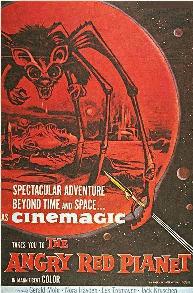Early Martian Sci-Fi

Peaceful Martians from Ray Bradbury's The Martian Chronicles. Taken from: http://humbabe.arc.nasa.gov/mgcm/fun/pop.html
Most of the first Martian sci-fi books were closely tied to the beliefs held by astronomers of the day. Schiaparelli himself wrote the post-script on Louis Pope Gratacap’s 1903 novel The Certainty of a Future Life on Mars, which was about human beings being reincarnated as aliens on Mars. Mars was usually described as socially superior to Earth, as in Edgar Welch’s 1883 novel Politics and Life in Mars: A Story of a Neighboring Planet.
Much of the fiction focussed on how we would contact the Martians. Percy Greg wrote Across the Zodiac: The Story of a Wrecked Record in 1880. In his book, humans developed a force field that worked by “negative gravity” to reach Mars. This inspired the idea of antigravity space travel. Robert Cromie’s 1890 novel A Plunge into Space also used antigravity spacecraft to reach Mars.
The Golden Age of Science Fiction

Picture from: http://war-of-the-worlds.org
In the 20th century, Mars moved from
novels to pulp magazines, cheap sci-fi comics that were created by imaginative
young writers. Some of the most popular titles were Amazing Stories
and Astounding Science Fiction. The pulp magazines were
so popular that they inspired two more genres: comic books and serial films
like Flash Gordon.
Near the end of the 19th century,
H.G. Wells wrote The War of the Worlds. This marked a turning point
in Martian science fiction, as the role of the Martian changed from peaceful
neighbor to threatening invader. Well’s novel was about the superior
technologically Martians invading Earth and eventually being destroyed
by the less advanced earthlings. Orson Wells adapted the book for
his famous radio broadcast on Halloween Eve, 1938. His radio play
was set-up like a mock newscast and, despite repeated disclaimers, it caused
a panic among thousands of listeners who believed we were really under
attack.
Martian Monster Movies

Taken from: http://humbabe.arc.nasa.gov/mgcm/fun/pop.html
The success of War of
the Worlds, along with other Mars related books and pulp comics, lead to
a boom of films concerning Martian invaders. Cashing in on Cold War
paranoia, these films were mainly B-movie monster flicks that portrayed
Martians as an alien menace that could masquerade as human. The Martian
menace was an obvious metaphor for the Red menace from the Soviet Union,
and audiences responded.
One of the earliest and most famous Martian invader
films was Invaders from Mars, released in 1953. The film concerns
a young boy who lives in a town where all the adults have begun acting
strange after he sees strange lights behind a hill near his town.
It turns out that the adults of the town have been taken under the control
of Martians. This is a similar theme in many Martian monster
movies, the idea of aliens taking control of human beings minds secretly.
Again, this stems from the Cold War paranoia of the time.
The most famous film with alien invader film
is Invasion of the Body Snatchers, released in 1956. This film concerns
another town where people begin to start acting weird. It turns out
that aliens have taken over various citizens’ bodies, and replaced them
with their own copy. Invasion of the Body Snatchers is looked at
by some people as a paranoid 1950’s anti-communism piece, or as a critical
look at McCarthyism and the Red Scare. Either way, few films
have been able to match the intense feelings of paranoia conveyed in the
film.
Mars in Modern Sci-Fi

Arnold Schwarzenegger in Total Recall. Image taken from: http://greatsci-fimovies.hypermart.net/total_recall
Over the next few decades, Mars’ place in pop culture changed. After the Mariner missions discovered that there is no advanced civilization on the Red Planet, Mars stopped being used as a serious metaphor for Cold War anxiety and began to be comedy fodder. From Chuck Jones’ “Marvin the Martian” Looney Tunes to “My Favorite Martian,” it looked as though a serious use of Martian threat was passé. Some serious Martian science fiction was still produced, most notably the works of Robert A. Heinlein and Philip Dick. And, some Martian movies are still produced, most notably Total Recall and Mars Attacks! However, the golden age of Martian sci-fi is clearly over, as the mystery of whether intelligent life exists has been answered. However, the mystery of whether life ever existed on Mars is still alive and well. In the next few years, missions to Mars will tells us more than we've ever known about the Red Planet. Perhaps their discoveries will trigger another boom like the one that happened in 1877 with Schiaparelli’s mistake.